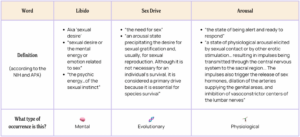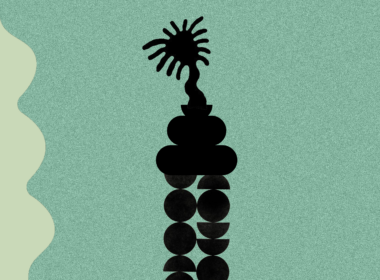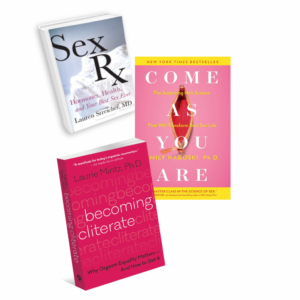The Difference Between Libido, Sex Drive, & Arousal
Before diving into the nitty-gritty of what is often referred to as “libido,” I want to clarify some of the language that we use during this conversation because some of these commonly used words might not mean what you previously thought. Let’s jump in and expand our vernacular!
While used interchangeably, “libido,” “sex drive,” and “arousal” actually refer to three different occurrences that happen in our bodies – all of which play important and different (though related) roles in human sexuality. The three terms are like cousins, not identical triplets.
Cousin number two is Libido, but her friends call her Sexual Desire. Libido is the life of the party and is in a constant mental state of wanting to have fun. If our cousin Desire all of a sudden stopped wanting to leave her house, we would know something was up. Similarly, within our bodies, libido is the mental and emotional energy that one has towards sex, and if all of a sudden, the desire stops entirely or decreases, that may be a sign from our body that something is going on.
Cousin number two, Sex Drive, is the dependable science nerd of the bunch. Sex drive is based on evolutionary and animalistic instincts that are inside us and have been since we, as humans, began as apes. While Libido may have hit the margaritas the night before, Sex Drive is our lifeline, always there in the morning with a glass of water and a breakfast sandwich. Animals and humans alike rely on our sex drives to survive. In order for us to exist, we need to procreate and our sex drive is there is remind us of this, whether or not it’s a conscious part of our sexual decision-making.
This isn’t to say, however, that people in same-sex relationships do not have a sex drive. Research has suggested that for many women, a “high sex drive is associated with increased sexual attraction to both women and men” and for men, “high sex drive is associated with increased attraction to one sex or the other, but not to both” in accordance with their sexual orientation.
The third and final cousin in our terrific trio is Arousal, and she is known for wearing her heart on her sleeve and for her complete inability to hide what she’s feeling. You can always tell what Arousal is feeling just from the expression on her face. In our bodies, arousal is just that – physical and physiological. Arousal specifically describes a physiological process – changes that happen in the body that are often visible or palpable. This is commonly referred to as being “turned on.” In females, indications of arousal include vaginal lubrication, vaginal tenting (the cervix lifts and vagina widens to accommodate penetration), erect nipples, increased heart rate, quicker breathing, increased blood flow to genitals, swelling of the clitoris and labia minora, etc. As someone becomes closer to reaching orgasm, these sensations can become more intense, the vagina will continue to swell from blood flow, the clitoris will become highly sensitive, and muscle tension will increase.
Sometimes, arousal is not something that we can control – for example, some people experience immense shame if their body becomes aroused during sexual abuse or assault, but arousal does not indicate consent or enjoyment – it is the physiological process that the body automatically carries out, without our conscious effort.

Causes of Low Libido
Many aspects of life can affect libido, or sexual desire, and it’s perfectly normal for sexual desire and libido to change and fluctuate during different stages of your life. Below you will see the causes of low libido divided into five groups: relationships, physical, hormonal, mental health, and self-perception.
Keep in mind that “low libido” is entirely subjective – ‘normal’ is different for everyone, and everyone’s sexual desire is different. Take the time to consider whether you feel you have a low libido (whatever that means for you) or maybe your libido is lower compared to another person who subjectively has a very “high libido.” There is no right or wrong – though if you are feeling unfulfilled by your sex life, then it’s something to look into.
Relationships
The Mayo Clinic lists the following as contributors to low sexual desire: lack of communication between partners, unresolved conflict, poor communication regarding sexual needs and preferences, and trust issues. Other relational problems that could put a strain on sexual desire include excess pressure to perform, boredom, and/or changes in attraction.
Physical
I think we can all agree that difficulty with arousal or lubrication and/or pain during sex definitely would not make us want to do it more. Sometimes these roadblocks are caused by chronic medical conditions, like underactive thyroid, arthritis, cancer, diabetes, high blood pressure, coronary heart disease, and neurological diseases. Other physical influences on our sexual desire include general fatigue, stress, anxiety, and let’s not forget alcohol, smoking, and drugs: “A glass of wine may put you in the mood, but too much alcohol can affect your sex drive. The same is true of street drugs. Also, smoking decreases blood flow, which may dull arousal.”
Sexual Dysfunction and Clinical Definitions
Sexual dysfunction is an umbrella term to describe certain medical diagnoses related to one’s dissatisfaction with their sexual practice. Any of these could contribute to or be the root cause of low libido.
Genital Arousal Disorder (GAD)
Planned Parenthood characterizes GAD as “when you have trouble getting or staying aroused (turned on) and you feel sad or worried about it.”
Hypoactive Sexual Desire Disorder (HSDD)
HSDD “is when you’re not interested in sex (have no sex drive or a low sex drive), and it bothers you. It’s one of the most common sexual problems that people have. This could be a lifelong concern, or it can happen over time. It may be a problem all of the time, or only happen in certain situations.”
Orgasm Disorder
Orgasm disorders, like nearly all sexual dysfunctions, have multiple potential causes and “happens when you don’t have orgasms, it takes a long time for you to orgasm, you have orgasms less often than you’d like, or your orgasms aren’t as strong as you would like, and you feel sad, or worried about it. It’s one of the most common sexual problems. It may be more common among transgender people.”
Vulvodynia or sexual pain disorder
These conditions describe ongoing vulvar pain or pain associated with sexual stimulation and/or vaginal contact.
Hormonal
A professor of human sexuality at NYU, Zhana Vrangalova, Ph.D. offers: “biological elements like pregnancy, ovulation, or being postpartum can all impact the ability to have a knee-jerk spontaneous desire for sex.” Some of the hormonal changes that can affect sexual desire include pregnancy, breastfeeding, postpartum depression, menopause, perimenopause, menstrual cycles, and hormonal contraceptives.
Mental Health
If you have a history of trauma or abuse (sexual, emotional, or physical), you may struggle with sexual intimacy or contact and that is not an abnormal response – it is one that can be worked upon with a therapist/counselor, often with great success. Also, for those who take selective serotonin reuptake inhibitors (SSRIs), a possible side effect is sexual dysfunction.
For many people and couples, the process of trying to become pregnant can be a roller coaster of emotions (about 10% of women between the ages of 15-44 struggle with fertility). Maintaining strict sexual schedules and having goal-oriented sex can add a lot of pressure to your sex life – especially if you remain unpregnant. This stress along with emotional turmoil takes a toll on sexual desire, particularly if sex starts to feel like a job or task that you have to do.
Self-perception
The final contributor to low libido that we will discuss is self-perception, which I would describe as how you experience your identity and how you experience your body. Libido can be drastically affected by gender dysphoria (discomfort in your assigned gender identity), discomfort with your sexual orientation, your self-esteem/body image, comfort with your own sexual agency, and even by self-consciousness surrounding a chronic STI diagnosis that you have.
Diagnosis of Low Libido
The best way to find answers to your concerns about sexual desire, or libido, is by talking to a medical professional – this could be a general practitioner, a psychologist, psychiatrist, sex therapist, OB/GYN, etc. Many specialists approach sexual dysfunction in different ways, so talking to multiple doctors isn’t a bad idea. Remember that this blog post is not medical advice nor should it be used as a tool for diagnosis. If you are concerned about something you read in this blog and how it might apply to your health, feel free to print it out or send it to your HCP.
Treatments, Solutions, & Next Steps
You can approach low libido from many angles. Below are some suggestions for each of the categories of causes outlined above.
Relationships
- Talk to your partner(s) about what you’re experiencing and feeling.
- Couples counseling
- Try something new together (or separately and report back)
- Have a ‘date night in’ and complete a Yes/No/Maybe List like this one from Sex with Emily
- Open up your relationship or consider ethical nonmonogamy (ENM)
- Take the pressure off by making sex less goal-oriented
Physical
- Use lots and lots of lube
- Try new ways of stimulation
- Address pain and its underlying causes by seeing a medical care provider (sex shouldn’t be painful unless you want it to be)
- Make lifestyle changes (drugs/alcohol/addressing stress)
Hormonal
- Talk with a doctor about how your contraceptive method might affect your sexual desire and how to counteract negative effects
- A doctor might test you for hormone imbalances
Mental Health
- Always consult your doctor before changing or stopping medications
- Discuss options of changing medications or supplementary medications to counteract the effects of SSRIs on sexual desire or pleasure
Self-Perception
- Create comfort (lighting, blankets, pillows, etc.)
- Talk about insecurities with a partner(s) and ways they can engage with you and not trigger them
- Discuss chronic STIs with a partner(s), use safer sex products as needed, and set boundaries for yourself and your partner so that everyone is comfortable
Want to learn more about low libido in women and females?
If you want to learn more, I recommend reading the following books…
By: Gigi Singer, MPH, Sexuality Educator







![The Drop by Rythm. 10 Best Sex toys for Women [For Beginners] by Gillian Gigi Singer. Sexual Wellness.](https://blog.itsrythm.com/wp-content/uploads/2022/07/The-10-Best-Sex-Toys-for-Women-Who-are-Beginners--768x423.jpg)
